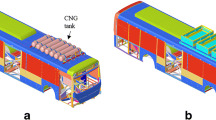Abstract
Due to the constraints of power battery energy density, light-weight electric bus body structure is attracting more and more attentions with the capability to extend mileage. In this paper, an aluminum-steel multi-material electric bus body structure is newly developed and corresponding design optimization is performed for lightweight design while satisfying the constraints. The finite element model of the bus body structure is constructed and validated by experimental modal test. The optimization objective is to minimize the total mass, while bending, torsional stiffness, bending and torsional frequency are chosen as the corresponding constraints. The thicknesses of the pre-determined components are screened out using sensitivity analysis to determine the candidate design variables. Continuous and discrete gradient-based optimizers are employed to generate the optimal solutions, which are demonstrated that these new designs could bring benefits in terms of structural performance and structural weight.











Similar content being viewed by others
References
Airale A, Carello M, Scattina A (2011) Carbon fiber monocoque for a hydrogen prototype for low consumption challenge. Mater Werkst 42(5):386–392
Bai YC, Zhou HS, Lei F, Lei HS (2018) An improved numerically-stable equivalent static loads (ESLs) algorithm based on energy-scaling ratio for stiffness topology optimization under crash loads. Struct Multidiscip Optim 59:117–130
Charles D, Pascal F (2018) Geometrical shape optimization in fluid mechanics using freefem++. Struct Multidiscip Optim 58(6):2761–2788
Chen JQ, Lan CF (2017) Design and analysis approaches to automotive structural lightweight. Beijing institute technology press, Beijing, China, pp 169–174
Chiandussi G, Avalle M (2002) Maximization of the crushing performance of a tubular device by shape optimization. Comput Struct 80(27–30):2425–2432
Chuang CH, Chen SK, Yang RJ, Vogiatzis P (2017) Topology optimization with additive manufacturing consideration for vehicle load path development. Int J Numer Methods Eng 113(8):1434–1445
Deng SG, Krishnan S (2015) Multi-constrained topology optimization via the topological sensitivity. Struct Multidiscip Optim 51(5):987–1001
Deng SG, Krishnan S (2016) Multi-constrained 3D topology optimization via augmented topological level-set. Comput Struct 170:1–12
Fan ZJ, Su RY, Gui LJ (2011) Multi-objective optimization for bus body with strength and rollover safety constraints based on surrogate models. Struct Multidiscip Optim 44(3):431–441
Gang WJ, Choi YM, Choi GJ (2008) Discrete thickness optimization of an automobile body by using the continuous-variable-based method. J Mech Sci Technol 22(1):41–49
Gao FL, Bai YC, Lin C (2018) A time-space kriging-based sequential metamodeling approach for multi-objective crashworthiness optimization. Appl Math Model 69:378–404
Hannan MA, Azidin FA, Mohamed A (2014) Hybrid electric vehicles and their challenges: a review. Renew Sust Energ Rev 29:135–150
Hu P, Han X, Silva LD et al (2013) Strength prediction of adhesively bonded joints under cyclic thermal loading using a cohesive zone model. Int J Adhes Adhes 41(3):6–15
Jin R, Chen W, Simpson TW (2001) Comparative studies of metamodelling techniques under multiple modelling criteria. Struct Multidiscip Optim 23(1):1–13
Joost WJ, Krajewski PE (2017) Towards magnesium alloys for high-volume automotive applications. Scr Mater 128:107–112
Kang N, Kokkolaras M, Papalambros PY et al (2014) Optimal design of commercial vehicle systems using analytical target cascading. Struct Multidiscip Optim 50(6):1103–1114
Kaya A, Mehmet S, Fehim F (2004) Effects of various parameters on dynamic characteristics in adhesively bonded joints. Mater Lett 58(27–28):3451–3456
Klein T, Mayer S, Usategui L et al (2017) Mechanical behavior and related microstructural aspects of a nano-lamellar tial alloy at elevated temperatures. Acta Mater 128:440–450
Li C, Jeswist J, Kim Y (2015) Conceptual and detailed design of an automotive engine cradle by using topology, shape, and size optimization. Struct Multidiscip Optim 51(2):547–564
Li L, Wang X, Song J (2017) Fuel consumption optimization for smart hybrid electric vehicle during a car-following process. Mech Syst Signal Process 87(1):17–29
Lin C, Bai YC, Gao FL (2018) An intelligent sampling approach for metamodel-based multi-objective optimization with guidance of the adaptive weighted-sum method. Struct Multidiscip Optim 57(3):1047–1060
Liu J, Zhang Y (2017) Soft network materials with isotropic negative poisson’s ratios over large strains. Soft Matter 14(5):693–703
Luo AA (2013) Magnesium casting technology for structural applications. J Magn Alloy 1(1):2–22
Pedersen NL, Pedersen P (2018) Buckling load optimization for 2D continuum models with alternative formulation for buckling load estimation. Struct Multidiscip Optim 58(5):2163–2172
Shan S, Kang SH, Zhao ZH et al (2015) Design of planar isotropic negative Poisson’s ratio structures. Extreme Mech Lett 4:96–102
Wu T, Liu K, Tovar A (2017) Multiphase topology optimization of lattice injection molds. Comput Struct 192:71–82
Yang J, Lu H, Lin G (2018) Progress on discontinuously reinforced titanium matrix composites. J Alloys Compd 767:1196–1215
Zhong W, Su RY, Gui LG, Fan ZJ (2016) Multi-objective topology and sizing optimization of bus body frame. Struct Multidiscip Optim 54(3):701–714
Funding
This work is supported by the National Natural Science Foundation of China (Grant No. 51805032), Beijing Institute of Technology Research Fund Program for Young Scholars, and the Science and Technology Planning Project of Beijing City (NO. Z161100001416007).
Author information
Authors and Affiliations
Corresponding author
Ethics declarations
Conflict of interest
The authors declare that they have no conflict of interest.
Additional information
Responsible Editor: Jianbin Du
Publisher’s note
Springer Nature remains neutral with regard to jurisdictional claims in published maps and institutional affiliations.
Rights and permissions
About this article
Cite this article
Fu, C.L., Bai, Y.C., Lin, C. et al. Design optimization of a newly developed aluminum-steel multi-material electric bus body structure. Struct Multidisc Optim 60, 2177–2187 (2019). https://doi.org/10.1007/s00158-019-02292-w
Received:
Revised:
Accepted:
Published:
Issue Date:
DOI: https://doi.org/10.1007/s00158-019-02292-w




